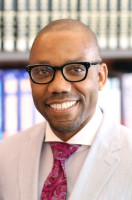Seeing blood spill from the body as oil spills into the ocean … how is a female not to fear for her life
Irish Brown wrote those lines in her poem “The Slip Up” hours after seeing a body sprawled outside her house. After the Martin Behrman Charter School student bore witness to the death, she went to school. Brown wrote the poem before an audition for a poetry reading that was scheduled later that day.
Our children are scared and have little choice but to name the threats that may consume them otherwise if ignored. Brown’s experience underlines why we need art in school.
Poetry is not a luxury for students living under the threat of violence. The title of that classic essay penned by acclaimed poet and activist Audre Lorde comes to life through the poetry of young people coping with the world around them.
Poetry gave Brown an outlet to gain some control over her life in ways that math or history could not. Through writing, Brown embraced that horrific scene so she could exert some power over it. In New Orleans — one of the most violent cities in America — students see and hear violence every day and it’s having a severe impact on them. Youth surveyed in the city showed signs of post-traumatic stress syndrome at more than 4 times the national average. Behrman Charter is making efforts empower students by hosting a poetry reading on the same streets where blood is spilled, helping them reclaim their city with their words.
The first Friday in May, Brown and other student performers from her school will present their views on justice and violence in their society, the theme of the third annual Poetry on the Avenue. Dozens of young poets and performers will speak on major social issues, according to a press release for the event.
Brown’s poetry is a window on how violence affects young people like her. So many public school students are concentrated in neighborhoods where there is so much violence to slip on.
We are all scared. But we should be brave enough to hear students like Brown name our fears …
In 2015, there were a total of 164 murders in New Orleans, according to a study on youth I led for the Data Center, a nonprofit research group. Of these murders, 11 were of children younger than 18, and 40 were young people between 18 and 24. The latter group represented only 10 percent of the city’s population that year but 24 percent of homicide victims. From 1985 through 2012, New Orleans was the city with the highest annual murder rate in the nation 12 times.

Brown’s reference to oil spills shows she is conscious of the environmental threats to the Louisiana coastline. The fear of another Deepwater Horizon oil spill, the largest on record, looms large as President Trump considers rolling back several safety regulations issued under President Obama. Trump’s proposed cuts to the National Endowment for the Arts erode access to art programs. In the decade that ended in 2000, elementary schools experienced a decline of approximately 20 percent in dance and drama opportunities, according to a national study.
The rest of us who live amid violence are also scared — but we’ve become numb to the reported statistics. Brown’s brave poetry forces us to face our own mortality as she comes face to face with hers.
Life is only temporary…
Don’t slip up and take a sip out of death’s cup…
Seeing the sight such as itself causes the mind to play tricks and these tricks ever so divine like rewind! I see you over and over again!
Her words are not sounding the alarm for her safety — which we already know to be constantly in peril — as much as they are a sign that she is learning to live gracefully and poetically in an ugly world.
Audre Lorde wrote, “Within these deep places, each one of us holds an incredible reserve of creativity and power, of unexamined and unrecorded emotion and feeling.”
We should hope that all students in New Orleans, Detroit and Baltimore, anywhere that violence and death are just around the corner, gain an education that will protect them.
Michael “Quess” Moore, resident artist at Behrman and creative director of Poetry on the Avenue explains that his students’ openness and vulnerability can be a source of protection. “There’s a power in vulnerability,” Moore says. “Their openness becomes their shield.” Brown transformed tragedy into a form of strength, he added.
We are all scared. But we should be brave enough to hear students like Brown name our fears when the rest of us don’t muster the words to change our world.
‘Cause no, mamma, I was caught with the handcuffs on
And we fought, but you took too long —
and now the jail birds get to hear my new rap song!
Bars!
Andre Perry, PhD, is a New Orleans educator and the host of “Free College” on WBOK 1230 radio, Tuesdays at 3 p.m. Tweet him @andreperryedu
This column is being published simultaneously by the The Hechinger Report, a nonprofit, independent news organization focused on inequality and innovation in education. Perry is a Hechinger contributing writer.
The opinion section is a community forum. Views expressed are not necessarily those of The Lens or its staff. To propose an idea for a column, contact Lens founder Karen Gadbois.



